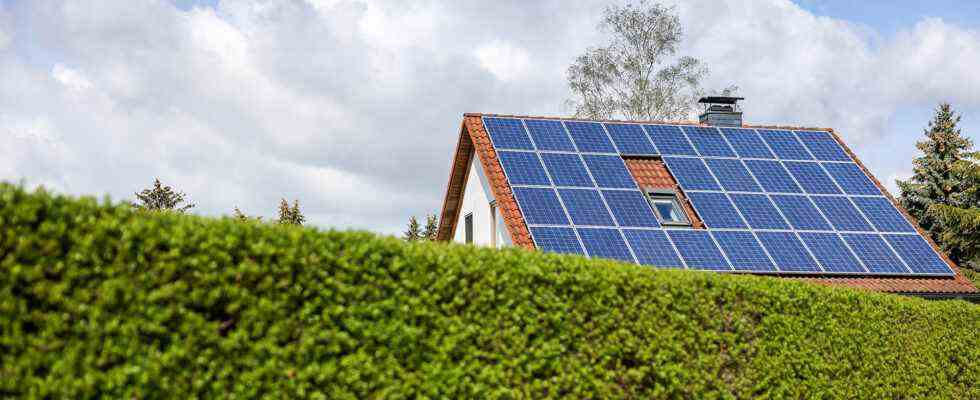As of: 02/13/2022 4:02 p.m
Photovoltaic was once considered a highly subsidized form of power generation. That has changed. In the meantime, owners of new systems receive less funding for the electricity they feed into the grid than it is actually worth on the market.
Contribute to the energy transition: Private individuals can do this, for example, with solar cells on their own roofs. This option is used a lot. There are now over two million photovoltaic systems in operation across Germany, most of them on the roofs of private households. For many years, the most important instrument for promoting the expansion of photovoltaics was the feed-in tariff under the Renewable Energy Sources Act (EEG). In other words, the guaranteed revenue per kilowatt hour of solar power that is fed into the power grid.
But this feed-in tariff has recently become less and less attractive. Because it continues to fall month by month in newly built photovoltaic systems. A symbolic point has now been reached: the feed-in tariff is even lower than the actual market price for electricity. Andreas Henze from the Bavarian Solar Association criticizes that the feed-in tariff can hardly be said to be a subsidy for solar power, “in fact it’s actually the opposite”. The additional electricity for Germany’s energy supply is urgently needed.
The scissors separate
In figures: Twenty years ago, the guaranteed feed-in tariff for systems with an output of up to ten kilowatt hours, as is common in single-family homes, was over 50 cents per kilowatt hour of solar power. Anyone who installs such a photovoltaic system today gets just 6.7 cents per kilowatt hour of electricity that he feeds into the grid – and thus almost one cent less than the average solar electricity fed in last year was worth on the electricity market. This annual market value calculated by the network operators for 2021 is 7.6 cents per kilowatt hour. Due to the increase in exchange electricity prices, this gap has widened, especially over the winter.
The reason for the higher price was partly special effects such as the increase in coal and gas prices due to the global economic recovery after the corona crisis – and the Ukraine conflict. In some cases, however, there are also permanent changes such as the rising CO2 price in EU emissions trading. The German Solar Industry Association doubts that the extreme increase in recent months will last. It remains to be seen where the price on the electricity market will eventually level off.
Large solar parks benefit
However, one thing is clear: Large plants that sell the electricity they generate directly benefit from the increased market prices for electricity and can generate additional income. Small systems on house roofs, on the other hand, have to continue to cope with the falling feed-in tariffs.
Behind this mechanism anchored in the EEG of constant deductions in the payment of solar power is the expectation that the solar modules and systems will become cheaper and cheaper over time. However, that is no longer true. In the meantime, the price for the installation of photovoltaic systems is rising again. This has to do with interruptions in supply chains due to Corona, reports Tobias Schmitt from the Munich solar company Emondo.
But not only. After all, large solar parks in particular are booming because they can sell their electricity directly on the market, bypassing the mechanisms of the EEG. This drives the demand for solar panels, which are needed for systems of all sizes. “Production can’t grow as quickly as the market demands at the moment,” says Schmitt, “and that won’t be over by tomorrow. So this problem will get worse.” For end customers, the systems are now about as expensive as they were in 2017 or 2018. The statutory feed-in tariff, on the other hand, is much lower than it was then.
High self-consumption is crucial
Photovoltaic systems on private houses are still worthwhile in many cases. But for this it is crucial that the owner uses as much of his electricity as possible himself. Because then he saves directly on his electricity bill, and it is currently getting higher and higher – due to the increased market prices for electricity. Solar companies are therefore currently reporting uninterrupted high demand in the single-family house segment.
But one problem remains: Because on the one hand self-consumption of solar power is becoming more and more worthwhile, on the other hand feeding it into the grid is becoming less and less, there is in many cases an incentive to plan the solar systems smaller than would actually be possible. After all, families can often only use a small proportion of the solar power from a system that fills the entire roof. This then reduces the return.
Solar companies report that, despite the low feed-in tariff, owners of private single-family homes are often persuaded to use their entire roof with photovoltaics when scaffolding is already in place. However, medium-sized systems on commercial roofs are badly affected. According to the German Solar Industry Association, there was a significant slump last year. Because using the electricity in the building itself is hardly possible, for example in warehouses with their large roofs.
Ministry promises comprehensive solar package
The Green-led Federal Ministry of Economics wants to present an urgent package on climate protection in the cabinet in April. It is said to contain a reform of the Renewable Energy Sources Act, with a “comprehensive package for solar energy”. A ministry spokeswoman wrote when asked by BR: “The aim of the solar package is to create greater incentives for the expansion of solar energy and also to make full use of the roofs.” The current situation on the electricity and plant market will be included. However, the ministry does not want to give details yet.

